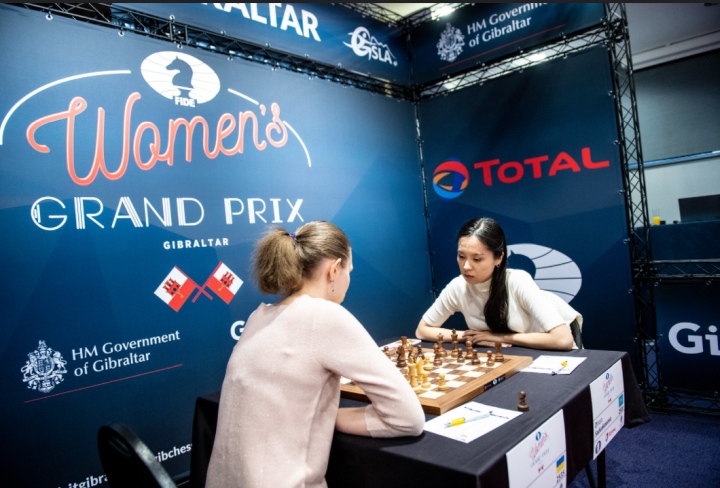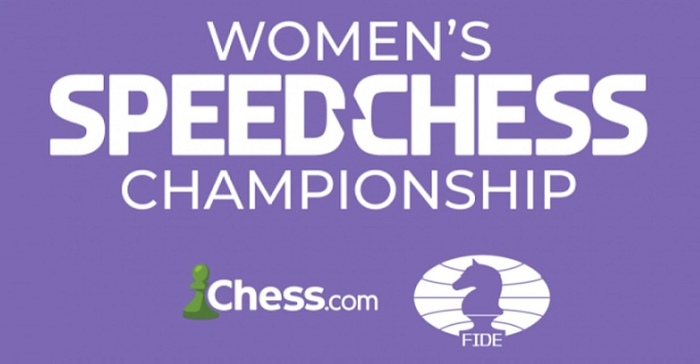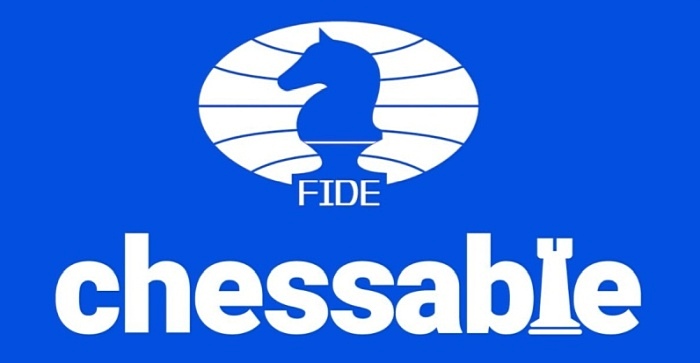Round 7: Black is more than OK

After another exciting day’s play and four decisive results, round seven of the Gibraltar leg of the FIDE Women’s Grand Prix at the Caleta Hotel on 29 May 2021 ended with Zhansaya Abdumalik of Kazakhstan in the lead on 5½, Mariya Muzychuk in second place on 5, and Kateryna Lagno of Russia and Gunay Mammadzada of Azerbaijan in joint third on 4½. In the race for the two places in the Candidates’ tournament, it was a good day for Humpy Koneru, watching from afar in India, and Kateryna Lagno, but a bad one for the other contenders, Nana Dzagnidze and Anna Muzychuk, who both lost with White and now have considerable ground to make up. Anna Muzychuk’s game with Dinara Saduakassova was an eventful battle. It started with an intriguing variation of the open Ruy Lopez, with Black sacrificing the exchange on move 24. On commentary, Veselin Topalov expressed some surprise about White’s 21.Ba2, as the light-squared bishop became vulnerable to the previously mentioned exchange sacrifice. He preferred 21.e6 followed by ideas such as Ne5. “Critical and natural,” as he put it. After the exchange sacrifice, Anna immediately went wrong with 26.Ra6, putting the rook seriously offside. Anna’s next move, 27.Ne5, left her kingside wide open to a wide range of tactics, although not so easy for humans to disentangle. However, Dinara soon hit on the best plan and finished the game in some style. This defeat put a severe dent in Anna’s hopes of qualifying for the Candidates’ tournament. As much as we feel sorry for her, we also have to be delighted for Dinara who has had a tough time in the first half of the tournament and has now recorded her first win. Nana Dzagnidze opened against co-leader Zhansaya Abdumalik with a London System (involving d4 and Bf4), which always used to be regarded as insipid but has now been in vogue for some years. On move 15 Zhansaya played 15…Qd8, allowing Nana to capture a pawn on b7. Zhansaya countered with 16…Nxd4 but the computers were flagging up 17.Bf1 as a strong reply. Nana opted for 17.Kf1 instead. Zhansaya was still walking a tightrope, but the Georgian failed to take advantage. Zhansaya deliberately conjured up a big mess on the board when Nana started getting short of time. Nana would still have been in the game had she found 24.Rcc4 but this was a deep computer game that no human could be expected to find. Thereafter the win was easy for Black. The result substantially increased the young Kazakhstani player’s chances of winning the tournament. A loss for Nana means her prospects of reaching the Candidates’ tournament have been affected. Humpy Koneru, no doubt following events in India, will be feeling that losses for Anna and Nana in this round have greatly increased her chances of playing in the Candidates’ event. Alina Kashlinskaya and Irina Bulmaga, both on 1½/6, had a discussion with a Bogo-Indian. One snag about the line chosen is that it gifts White the two bishops. Perhaps 15…Nxd2 was an improvement for Black. As played, White gained space and was able to follow her plan while Black had difficulty in unravelling her slightly cramped position. On move 30 Black might have been able to fight on but 30…Ng8 allowed a move forcing the win on the f7-pawn, after which White’s attack broke through quickly. Irina paid her opponent the courtesy of playing through to checkmate. Elisabeth Paehtz defended against Kateryna Lagno’s e4 with a Najdorf Sicilian, which usually results in some entertaining chess. However, Elisabeth settled for something more restrained and, as the material was exchanged, the game was soon headed for a quiet conclusion. Kateryna could still be well content with her day as her two rivals for the Candidates’ place, Nana and Anna, had lost with White. With four rounds remaining, she is a clear point ahead of Nana and 1½ points ahead of Anna, and her rivals need to overtake her to, not simply finish level with her. The battle of the former world champions, Mariya Muzychuk and Antoaneta Stefanova, started in a strange way with an unusual treatment of the Queen’s Gambit for Black by Antoaneta. Her fellow countryman Veselin Topalov, making his debut as commentator today, admitted on commentary that he didn’t understand Antoaneta’s plan of 3…a6 followed by 5…Nc6. He also questioned moves such as 8…f5 and 9…h5, weakening the dark squares. Mariya held a stable plus, but much depended on the e4 break, which she opted for as soon as it became feasible on move 19. The position soon looked miserable for Black when White lodged a knight on f4 and menacing a number of weak white squares in the Black camp. Antoaneta later admitted she was lost, though there were still some complications. Then, just as the players reached the time control, Mariya allowed a trick. Antoaneta checked with the queen, sacrificed a rook on b2, and then infiltrated the white camp with her queen. At first sight, it didn’t look like a perpetual check as the queen was only supported by a pawn on c4. But perpetual check it proved to be and Antoaneta had escaped with a draw. The longest game of the day, Valentina Gunina, playing White against Gunay Mammadzada, saw the Russian GM play a restrained line, the Closed Sicilian, against Gunay’s 1…c5. Commentator Veselin Topalov wasn’t sure about Gunay’s plan of 8…h5, though Stockfish seems to favour it. Valentina opted for a queenside thrust with 12.b4, which looked promising but needed to be followed up accurately. Soon the game became complicated and descended into a slugging match. Eventually, Gunay emerged with extra material after Valentina blundered with 47.Be2. In desperation, Valentina sacrificed a second piece to create chaos, but it didn’t really work and Gunay could return one piece and retained a stable material advantage. Still, Valentina fought on, as she always does, but Gunay didn’t buckle under the pressure of having to play purely on the increment. Valentina is a tough fighter but she finally had to call it a day on move 96. Another excellent
Vaishali R. wins Qualifier II

WGM Vaishali R. became the second player to qualify for the main event of the 2021 Women’s Speed Chess Championship. She is the second player from India to make it to the final stage of this prestigious online competition. This qualifier was a 9-round Swiss tournament (3+1 time control), with the top eight finishers advancing to the knockout playoff stage. In the semifinals, Vaishali R. defeated Bibisara Assaubayeva 2-0, whereas Polina Shuvalova (Russia) who had reached semis the day before made it one step further this time after besting Karina Ambartsumova by the same score 2-0. The final started with a drama in the first game – the Indian GM completely outplayed her Russian opponent in a knight-vs.-bishop endgame with black pieces but lost on time in an absolutely winning position (most likely due to some connectivity issue). With her back against the wall, Vaishali R. launched a furious attack in game two, checkmated Black’s king and levelled the score. The third and final game turned into a roller-coaster. The Indian obtained a very promising position from the opening but spoiled it by hastily sacrificing her queen for a rook and minor piece. Polina seemed in full control but then she made a terrible blunder in mutual time scramble that cost her dearly. Vaishali emerged up a rook and sealed her spot in the main event of the 2021 Women’s Speed Chess Championship. The next qualifier will happen on Sunday, May 30 starting at 7 a.m. Pacific/16:00 CEST. The FIDE Chess.com 2021 Women’s Speed Chess Championship is an online competition for titled female players. The qualifiers for the event will happen from May 28-June 6, while the main event runs June 10-July 3. Players will battle for their share of a total prize fund of $66,000. One player from each playoff qualifier will move on to the main event. There they will be joined by eight invited players: GM Humpy Koneru (IND), GM Alexandra Kosteniuk (RUS), GM Antoaneta Stefanova (BUL), GM Anna Muzychuk (UKR), GM Irina Krush (USA), GM Kateryna Lagno (RUS), GM Lei Tingjie (CHN). Fans can follow the FIDE Chess.com Women’s Speed Chess Championship by watching the live broadcast with expert commentary on Chess.com/TV and Chess.com’s Twitch channel. They will also be able to enjoy the event through Chess.com’s Events page (https://www.chess.com/events). More info and a full schedule of the FIDE Chess.com Women’s Speed Chess Championship can be found here.
Shamsiddin Vokhidov clinches Asian Hybrid Championship title

Shamsiddin Vokhidov became the winner of the Asian Individual Hybrid Chess Championship. The 19-year old from Uzbekistan (pictured below) scored 7 out of 9 tied for first place with IM Tin Jingyao (Singapore) but came out on top thanks to better tiebreaks (average rating of the opponents). The champion beat a leader Temour Kuybokarov in a critical Round 8 clash and then drew the last round game with Tin Jingyao. The event, a 9-round Swiss tournament took place from May 21-29 on Tornelo platform. The top seven finishers qualified for the FIDE World Cup, which will be held in Sochi, Russia (July 2021). Photo: Galina Popova It is worth noting that the top-rated player Parham Maghsoodloo did not make the cut, whereas Tin Jingyao (ranked 19) and Mohamad Ervan (ranked 36) caused a minor sensation and punched the tickets to Sochi. Given that Temur Kuybokarov and Nodirbek Yakubboev qualified for the FIDE World Cup 2021 via Zonal 3.6 and 3.4 respectively, Sugar Gan-Erdene (Mongolia) and Lu Shanglei (China) who finished just outside of top-7 also can pack their bags for the trip to Russia. Since the Indian players were unable to take part in the tournament due to the pandemic and new restrictions, one spot in the FIDE Word Cup is granted for the Indian Chess Federation. Final standings: 1 GM Vokhidov, Shamsiddin UZB 2529 7 2 IM Tin, Jingyao SGP 2482 7 3 GM Kuybokarov, Temur AUS 2549 6½ 4 GM Tabatabaei, Amin IRI 2613 6½ 5 GM Yakubboev, Nodirbek UZB 2605 6½ 6 IM Ervan, Mohamad INA 2356 6½ 7 GM Sindarov, Javokhir UZB 2544 6½ 8 IM Gan-Erdene, Sugar MGL 2419 6 9 GM Lu Shanglei CHN 2615 6
From “flashcards” to Chessable

We’ve received many congratulations and positive words about FIDE’s new partnership with Chessable, the world’s leading and largest chess e-learning platform. However, for those of you not yet familiar with our new sponsors, we would like to share a bit more about Chessable and their mission to help make learning chess more fun and efficient, while making chess education a more professional and sustainable career for all. These are values that both FIDE and Chessable share, making them a perfect partner for FIDE in the years to come. Chessable’s staff consists of certified chess coaches, grandmasters and scientists in the field of educational psychology. Chessable’s CEO David Kramaley himself is a published scientific author on the topic of chess improvement. So, what is Chessable? Chessable.com is a comprehensive and social learning website that offers interactive chess courses with and without video instruction on all possible areas of expertise such as openings, endgames, tactics, strategy and more. Chessable also offers interactive versions of classic chess books built on top of its unique MoveTrainer™ software. Chessable’s online library of courses has quickly grown to be one of the largest in the world with hundreds of exclusive courses free and paid, by top players and coaches, including world champion Magnus Carlsen. What makes Chessable different and unique? With its MoveTrainer™ software, Chessable utilizes two main concepts – spaced repetitions/scheduling and gamification – and relies on a scientific approach. How does it work? By now, we think the story of the Polgar family’s famous private flashcard system, the “cartothec”, is no longer a secret in the chess world. It was a key part of the Polgar sisters’ tremendously successful training regimen. Photo courtesy of the Polgar family In many ways, Chessable has taken this classic idea of “flashcards” to a whole new level. On Chessable everything is an interactive flashcard. Opening lines, endgame positions, tactics, and grandmaster games are given to students as part of an online curriculum, a course. Sometimes the student starts by copying the moves shown and is then asked to repeat them to show he has learned them. At other times the student is quizzed to show what he has already learned. All of the student’s progress is stored on the site and served back in timed intervals until the student can play the moves perfectly. Students can earn points and badges for their progress making the act of studying itself a game! Chessable saves coaches and students alike enormous amounts of time by having all of the positions already preloaded on the site making it instantly accessible and instantly trainable. “My experience with the Chessable digital version of 100 Endgames You Must Know (by New In Chess) was highly favourable. Because I’m a data nut, I can tell you exactly how long it took me to go through the paper version in 2008, setting the board included: 88 hours. That doesn’t include positions I photocopied and carried with me, but actual sit-down time with the book and board. The Chessable version has taken me 34 hours (and change), and I’ve gone through the book more than 9 times already. The degree of efficiency, not having to deal with setting up the board, is outrageous”, says David Milliern, a Chessable student. To top it off, most authors on Chessable are active on the site and readily answer questions by students and coaches in the comments section under the trainable positions, making the study experience both a social and an educationally complete tool for anyone interested to improve. FIDE Official Chess Learning Partner
Harika Dronavalli wins Qualifier I

Harika Dronavalli (India) became the first player to qualify for the Main Event of the 2021 Women’s Speed Chess Championship, after beating Le Thao Nguyen Pham (Vietnam) in the final of the Qualifier I playoffs on May 28. This qualifier was a 9-round Swiss tournament (5+1 time control), with the top eight finishers advancing to the knockout playoff stage. In the semifinals, Harika defeated Bibisara Assaubayeva from Kazakhstan (1.5-0.5) whereas Le Thao Nguyen Pham broke down the resistance of Polina Shuvalova (Russia) only in the third game to advance into the final. It was all Dronavalli in the final who convincingly outplayed her Vietnamese opponent in both games and secured her spot in the Main Event of the 2021 Women’s Speed Chess Championship. “It feels really good. Since we have so many qualifiers you don’t know when you actually qualify and you have to work hard every day. So it is very good to qualify on Day 1” said the happy winner in a short interview after the final Qualifier II will be on May 29 at 7 a.m. Pacific/16:00 CEST. The FIDE Chess.com 2021 Women’s Speed Chess Championship is an online competition for titled female players. The qualifiers for the event will happen from May 28-June 6, while the main event runs June 10-July 3. Players will battle for their share of a total prize fund of $66,000. One player from each playoff qualifier will move on to the main event. There they will be joined by eight invited players: GM Humpy Koneru (IND), GM Alexandra Kosteniuk (RUS), GM Antoaneta Stefanova (BUL), GM Anna Muzychuk (UKR), GM Irina Krush (USA), GM Kateryna Lagno (RUS), GM Lei Tingjie (CHN). Fans can follow the FIDE Chess.com Women’s Speed Chess Championship by watching the live broadcast with expert commentary on Chess.com/TV and Chess.com’s Twitch channel. They will also be able to enjoy the event through Chess.com’s Events page (https://www.chess.com/events). More info and a full schedule of the FIDE Chess.com Women’s Speed Chess Championship can be found here.

